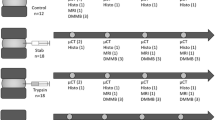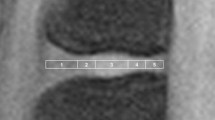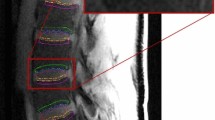Abstract
The cartilaginous endplate is important for the intervertebral disc health, and highly correlated with disc degeneration process. Therefore, understanding morphology and pathophysiology of the cartilaginous endplate is a critical step towards the diagnosis and prognosis of the disc health. This review briefly covers basic anatomy of the intervertebral disc and the cartilaginous endplate and describes how the cartilaginous endplate plays a role in the disc degeneration process. This review also discusses about the current diagnostic tools and methods of the disc health assessment along with its limitations and challenges, followed by recent technical developments in virtue of magnetic resonance imaging. Undoubtedly, magnetic resonance imaging is known to be remarkably beneficial for investigating the intervertebral disc and the cartilaginous endplate, and the number of studies on the cartilaginous endplate utilizing magnetic resonance imaging is increasing in recent years as evaluating the morphology and composition of the cartilaginous endplate can be a good tool for prognosis of the disc degeneration. The state-of-the-art MRI systems and imaging techniques can be a solution to the new findings regard to the disc health and its prognosis employing the cartilaginous endplate as a biomarker.
Similar content being viewed by others
References
Maniadakis N, Gray A. The economic burden of back pain in the UK. Pain. 2000; 84(1):95–103.
UK BEAM Trial Team. United Kingdom back pain exercise and manipulation (UK BEAM) randomised trial: cost effectiveness of physical treatments for back pain in primary care. BMJ. 2004; 329:1381–1385.
Katz JN. Lumbar disc disorders and low-back pain: socioeconomic factors and consequences. J Bone Joint Surg Am. 2006; 88(suppl 2):21–24.
Luo X, Pietrobon R, Sun SX, Liu GG, Hey L. Estimates and patterns of direct health care expenditures among individuals with back pain in the United States. Spine. 2004; 29(1):79–86.
Yao FS, Fontes ML, Malhotra V. Yao and Artusio’s anesthesiology: problem-oriented patient management. Hagerstown, MD: Lippincott Williams & Wilkins; 2011.
Palmer KT, Walsh K, Bendall H, Cooper C, Coggon D. Back pain in Britain: comparison of two prevalence surveys at an interval of 10 years. BMJ. 2000; 320(7249):1577–1578.
Luoma K, Riihimaki H, Luukkonen R, Raininko R, Viikari-Juntura E, Lamminen A. Low back pain in relation to lumbar disc degeneration. Spine. 2000; 25(4):487–492.
Peng B, Hou S, Wu W, Zhang C, Yang Y. The pathogenesis and clinical significance of a high-intensity zone (HIZ) of lumbar intervertebral disc on MR imaging in the patient with discogenic low back pain. Eur Spine J. 2006; 15(5):583–587.
Videman T, Nurminen M. The occurrence of annular tears and their relation to lifetime back pain history: a cadaveric study using barium sulfate discography. Spine. 2004; 29(23):2668–2676.
Cheung KM, Karppinen J, Chan D, Ho DW, Song YQ, Sham P, Cheah KS, Leong JC, Luk KD. Prevalence and pattern of lumbar magnetic resonance imaging changes in a population study of one thousand forty-three individuals. Spine. 2009; 34(9):934–940.
Furman MB, Tekmyster G, Simon J, Puttlitz KM, Falco FJE. Cervical Disc Disease. In: Dugs, Diseases & Procedures. Medscape Reference. 2011. http://emedicine.medscape.com/article/305720-overview#a0101. Accessed Dec 2012.
Raj PP. Intervertebral disc: anatomy-physiology-pathophysiologytreatment. Pain Pract. 2008; 8(1):18–44.
Urban JP, Maroudas A, Bayliss MT, Dillon J. Swelling pressures of proteoglycans at the concentrations found in cartilaginous tissues. Biorheology. 1979; 16(6):447–464.
Nap RJ, Szleifer I. Structure and interactions of aggrecans: statistical thermodynamic approach. Biophys J. 2008; 95(10):4570–4583.
Adams MA, Roughley PJ. What is intervertebral disc degeneration, and what causes it? Spine. 2006; 31(18):2151–2161.
Huber G, Morlock MM, Ito K. Consistent hydration of intervertebral discs during in vitro testing. Med Eng Phys. 2007; 29(7):808–813.
Martin MD, Boxell CM. Pathophysiology of lumbar disc degeneration: a review of the literature. Neurosurg Focus. 2002; 13(2):E1.
Roberts S, Evans H, Trivedi J, Menage J. Histology and pathology of the human intervertebral disc. J Bone Joint Surg Am. 2006; 88(suppl 2):10–14.
Roberts S, Menage J, Urban JPG. Biomechanical and structural properties of the cartilage end-plate and its relation to the intervertebral disc. Spine. 1989; 14(2):166–174.
Roberts S, Urban JPG, Evans H, Eisenstein SM. Transport properties of the human cartilage endplate in relation to its composition and calcification. Spine. 1996; 21(4):415–420.
Nachemson A, Lewin T, Maroudas A, Freeman MAR. In vitro diffusion of dye through the end-plates and annulus fibrosus of human lumbar intervertebral discs. Acta Orthop Scand. 1970; 41(6):589–607.
Pfirrmann CW, Metzdorf A, Zanetti M, Hodler J, Boos N. Magnetic resonance classification of lumbar intervertebral disk degeneration. Spine. 2001; 26(17):1873–1878.
Thompson JP, Pearce RH, Schechter MT, Adams ME, Tsang IK, Bishop PB. Preliminary evaluation of a scheme for grading the gross morphology of the human intervertebral disc. Spine 1990; 15(5):411–415.
Modic MT, Steinberg PM, Ross JS, Masaryk TJ, Carter JR. Degenerative disk disease: assessment of changes in vertebral body marrow with MR imaging. Radiology. 1988; 166:193–199.
Marinelli N, Haughton V, Muñoz A, Anderson PA. T2 relaxation times of intervertebral disc tissue correlated with water content and proteoglycan content. Spine. 2009; 34(5):520–524.
Perry J, Haughton V, Anderson PA, Wu Y, Fine J, Mistretta C. The value of T2 relaxation times to characterize lumbar intervertebral disks: preliminary results. AJNR Am J Neuroradiol. 2006; 27(2):337–342.
Kerttula L, Kurunlahti M, Jauhiainen J, Koivula A, Oikarinen J, Tervonen O. Apparent diffusion coefficients and T2 relaxation time measurements to evaluate disc degeneration. A quantitative MR study of young patients with previous vertebral fracture. Acta Radiol. 2001; 42(6):585–591.
Rajasekaran S, Babu JN, Arun R, Armstrong BR, Shetty AP, Murugan S. A study of diffusion in human lumbar discs: a serial magnetic resonance imaging study documenting the influence of the endplate on diffusion in normal and degenerate discs. Spine. 2004; 29(23):2654–2667.
Chiu EJ, Newitt DC, Segal MR, Hu SS, Lotz JC, Majumdar S. Magnetic resonance imaging measurement of relaxation and water diffusion in the human lumbar intervertebral disc under compression in vitro. Spine. 2001; 26(19):437–444.
Nguyen AM, Johannessen W, Yoder JH, Wheaton AJ, Vresilovic EJ, Borthakur A, Elliott DM. Noninvasive quantification of human nucleus pulposus pressure with use of T1r-weighted magnetic resonance imaging. J Bone Joint Surg Am. 2008; 90(4):796–802.
Johannessen W, Auerbach AD, Wheaton AJ, Kurji A, Borthakur A, Reddy R, Elliott DM. Assessment of human disc degeneration and proteoglycan content using T1ρ-weighted magnetic resonance imaging. Spine. 2006; 31(11):1253–1257.
Wang C, McArdle E, Fenty M, Witschey W, Elliott M, Sochor M, Reddy R, Borthakur A. Validation of sodium magnetic resonance imaging of intervertebral disc. Spine. 2010; 35(5):505–510.
Insko EK, Clayton DB, Elliott MA. In vivo sodium MR imaging of the intervertebral disk at 4 T. Acad Radiol. 2002; 9(7):800–804.
Yoder JH, Moon SM, Wright AC, Vresilovic EJ, Elliott DM. High resolution 3D MRI to quantify human disc tear geometry and location. Conf Proc in ISSLS annual meeting. 2011; 37.
Kakitsubata Y, Theodorou DJ, Theodorou SJ, Trudell D, Clopton PL, Donich AS, Lektrakul N, Resnick D. Magnetic resonance discography in cadavers: tears of the annulus fibrosus. Clin Orthop Relat Res. 2003; 407:228–240.
Moon SM, Yoder JH, Wright AC, Smith LJ, Vresilovic EJ, Elliott DM. Evaluation of intervertebral disc cartilaginous endplate structure using magnetic resonance imaging. Eur Spine J. 2013; 22(8):1820–1828.
Moon SM, Yoder JH, Vresilovic EJ, Elliott DM, Wright AC. Accurate measurement of cartilaginous endplate of the intervertebral disc of in vivo MRI data. Conf Proc in ISMRM Melbourne, Australia, 2012; 1386.
Bae WC, Yoshikawa T, Znamirowski R, Hemmad AR, Vande Berg BC, Chung CB, Masuda K, Bydder GM. Ultrashort timetoecho MRI of human intervertebral disc endplate: association with disc degeneration. Conf Proc in ISMRM Stockholm, Sweden, 2010; 534.
Law TK, Samartzis D, Kim M, Chan Q, Khong PL, Cheung KMC, Anthony M. Ultrashort time-to-echo MRI of the cartilagenous endplate and relationship to degenerative disc disease and schmorl’s nodes. Conf Proc in ISMRM, Montreal, QC, 2011; 570.
Bae WC, Xu K, Hemmad AR, Inoue N, Bydder GM, Chung CB, Masuda K. Ultrashort time-to-echo MRI of human intervertebral disc endplate: association with endplate calcification. Conf Proc in ISMRM, Stockholm, Sweden, 2010; 3218.
Author information
Authors and Affiliations
Corresponding author
Rights and permissions
About this article
Cite this article
Moon, S.M. Challenges and advances in MR imaging of the intervertebral disc — Can the cartilaginous endplate be a biomarker for the disc health?. Biomed. Eng. Lett. 4, 19–24 (2014). https://doi.org/10.1007/s13534-014-0123-5
Received:
Revised:
Accepted:
Published:
Issue Date:
DOI: https://doi.org/10.1007/s13534-014-0123-5




